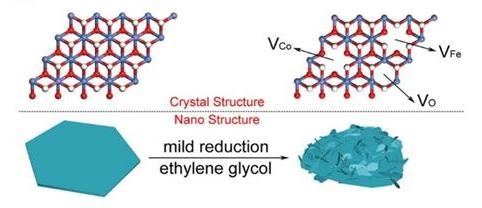Jun 28 2019
The adverse reaction in water splitting is the oxygen evolution reaction (OER) with slow reaction kinetics and huge over-potential that holds promise for energy storage and conversion.
 Illustration of the solvothermal reaction of pristine CoFe LDHs by using ethylene glycol. (Image credit: Science China Press)
Illustration of the solvothermal reaction of pristine CoFe LDHs by using ethylene glycol. (Image credit: Science China Press)
Nevertheless, it is still the bottleneck reaction of the water-splitting system due to the sluggish kinetics and huge over-potential during the anodic polarization process. Hence, it is important to create highly efficient OER catalysts that can efficiently reduce the over-potential and speed up reaction kinetics.
Several studies have currently shown CoFe double metal oxides or hydroxides to be effective catalysts for catalyzing OER. Conversely, the performance of the corresponding bulk catalysts is still inadequate for practical applications. On this basis, it is considerably important to realize the simultaneous enhancement of the obvious activity and intrinsic activity of CoFe-based catalysts through the engineering of material nanostructures and regulation of electronic structures.
Based on the defect engineering strategy, a team led by Professor Shuangyin Wang from Hunan University, recently used a mild reducing agent called ethylene glycol as a solvent in the solvothermal reduction of bulk CoFe LDHs to attain defects construction.
Such treatment achieved the development of anion and cation defects (O, Co, and Fe), and the bulk CoFe LDHs were in situ exfoliated, and a 3D hierarchical structure was eventually created because of the intercalation impact of large-sized ethylene glycol at the time of the solvothermal process.
Following further morphology and electronic structure characterization, the researchers identified that the defect-rich structure considerably improved the material’s intrinsic activity, and the resultant 3D hierarchical structure supported the mass transfer in the catalytic process, eventually realizing effective OER performance.
In addition, when compared to traditional 2D material exfoliation or defect construction techniques, this approach gets through the bottleneck of scale-up exfoliation of 2D material, and the in-situ development of 3D structure and exfoliation of 2D catalyst are achieved by an easy single-step solvothermal technique. It offers a new path for the large-scale preparation and application of OER catalysts.
The study was funded by the Fundamental Research Funds for the Central Universities (Grant Nos. 531107051102), the National Natural Science Foundation of China (Grant No. 51402100, 21573066, and 21522305) and the Provincial Natural Science Foundation of Hunan (Grant no. 2016TP1009) and the Shenzhen Discovery Funding (JCYJ20170306141659388).